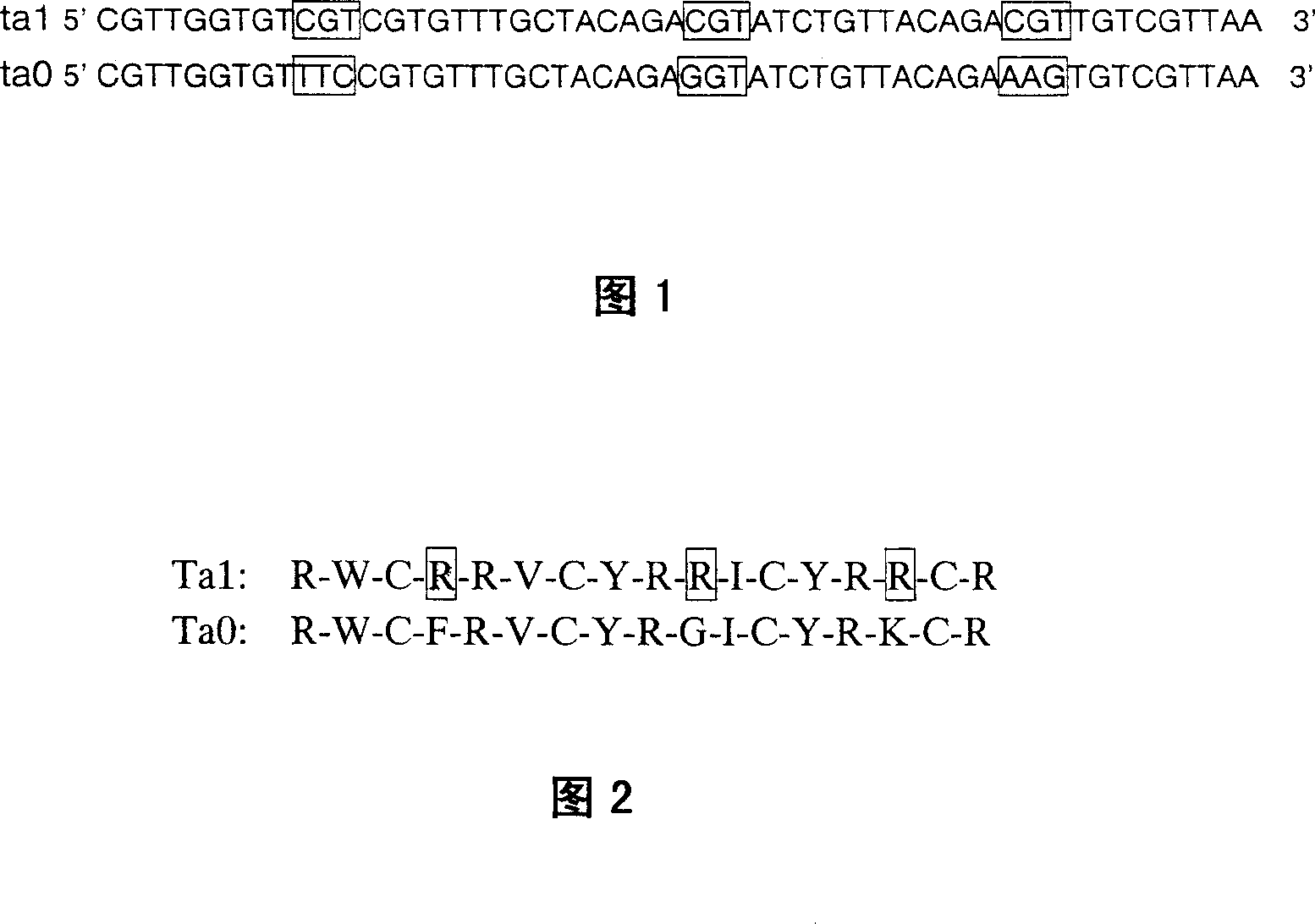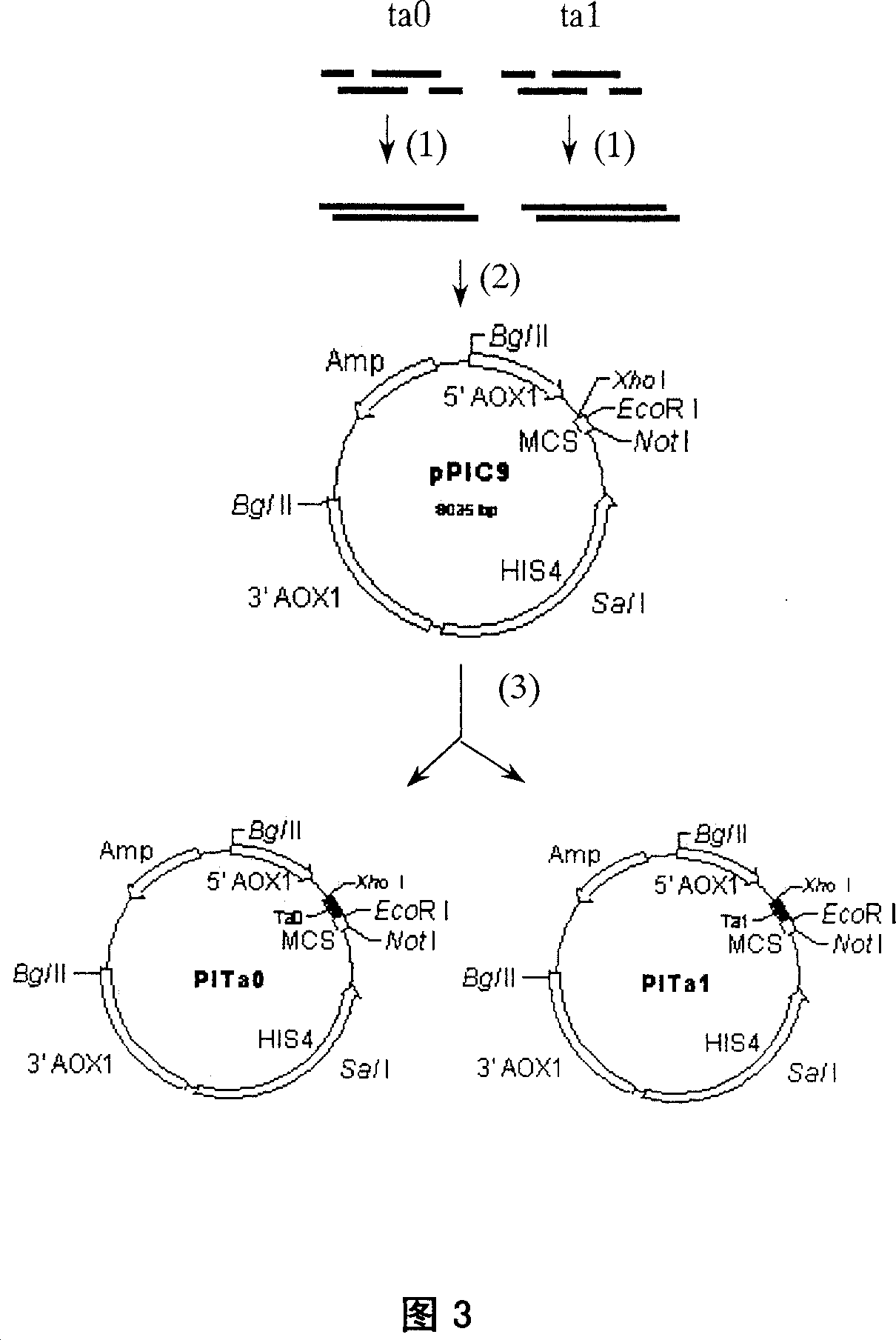Method of improving king crab element gene with higher antibacterial activity and high effect expression
A technology of gene and lysate, which is applied in the field of lysate gene and its expression, can solve the problems of low yield of antimicrobial peptides and difficulty in mass production
- Summary
- Abstract
- Description
- Claims
- Application Information
AI Technical Summary
Problems solved by technology
Method used
Image
Examples
Embodiment 1
[0039] This example illustrates the design, synthesis and cloning procedures of the gene encoding limulusin ta1.
[0040] Ta1 is based on the natural limulin Tachyplesin II (referred to as Ta0), some of its amino acids are replaced, and the original sequence amino acids K, G, F are replaced by R, the purpose is to increase its positive charge, especially the positive charge at both ends after the formation of β-fold , so as to improve its bactericidal / bacteriostatic activity, the synthesized nucleotide sequence is shown in SEQ ID No: 1, and the amino acid sequence is shown in SEQ ID No: 2. In order to be suitable for connecting to the yeast expression vector pPIC9 and integrating into the yeast chromosome for secretory expression, a sequence is added in front of it L-E-K-R * E-A-E-A . The product of the yeast KEX 2 gene recognizes E-K-R * E-A- E-A , and cut at the center. E-A Repeated cleavage of the KEX 2 gene product is not necessary but significantly increases it...
Embodiment 2
[0042] This example illustrates the process of yeast transformation and screening of recombinant yeast strains. After the DNA of plasmids PITa0 and PITa1 is electroporated to transform yeast cells, the target gene can be integrated into the recipient yeast genome through in vivo recombination. In the presence of exogenous inducer methanol, the AOX1 promoter can promote the expression of its downstream genes, and the signal peptide can guide the expression product to enter the secretion pathway of yeast. After cleavage, the exogenous protein product is finally secreted out of the cell.
[0043] Firstly, the DNAs of plasmids PITa0 and PITa1 (purified by PEG method) were respectively digested with 2-3 times excess endonuclease BglII, and electrophoresis was used to detect whether the digestion was complete and linearized. It was extracted with phenol, precipitated with ethanol, washed twice with 70% ethanol, freeze-dried, dissolved in sterile water, and stored at -20°C for future...
Embodiment 3
[0048] This example is to illustrate the determination procedure of the antibacterial activity spectrum of lysate expressed by recombinant yeast. After the recombinant yeast was induced and cultured at 30°C (yeast induction medium BMGY) for 36 hours, 5-10 μL of the supernatant was taken for measurement. The main purpose is to detect the antibacterial activity of Ta0 and Ta1 against some common livestock and poultry pathogenic bacteria, pathogenic fungi, and mildew fungi, and then measure against some production bacteria and beneficial bacteria.
[0049] The antibacterial activity of limulusin on bacteria is mainly measured by punching holes on the medium plate, adding 5-10 μL of fermentation broth to the holes, culturing at 37°C or 28°C for 16-24 hours, and measuring the diameter of the inhibition zone. Antibacterial assays were performed on some Gram-negative and Gram-positive bacteria, respectively. Gram-negative bacteria include: Escherichia coli JM109 and K12, Salmonella ...
PUM
 Login to View More
Login to View More Abstract
Description
Claims
Application Information
 Login to View More
Login to View More - R&D Engineer
- R&D Manager
- IP Professional
- Industry Leading Data Capabilities
- Powerful AI technology
- Patent DNA Extraction
Browse by: Latest US Patents, China's latest patents, Technical Efficacy Thesaurus, Application Domain, Technology Topic, Popular Technical Reports.
© 2024 PatSnap. All rights reserved.Legal|Privacy policy|Modern Slavery Act Transparency Statement|Sitemap|About US| Contact US: help@patsnap.com










